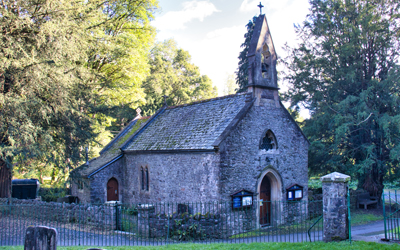A History of St Andoenus'
The church is dedicated to St Andoenus, who has been identified by some with St Owen, and by others as an obscure Greek saint. It has been suggested that St Owen was initially a 7th Century French scribe, but became Bishop of Rouen and Chancellor to three French monarchs. He is represented in the grouped parish logo by the quill of the scribe.
The church was wholly rebuilt in 1880 to designs of architect Walter Evill of Chepstow. The church nave and chancel were built contemporaneously in 1880 and the north vestry was added a short time later.The furnishings in the sanctuary are mainly a memorial to Captain Ian Oswald Lidell, VC, 5th Batallion Coldstream Guards, who was killed in action in 1945. The stained glass windows are memorials to the Evill and Bragington families. The stained glass includes works by Reginald Bell (1933), MF Farrar Bell (1962) and Celtic Studies (1979).
One of the gravestones, to a Christopher Cooper who died on 8th April 1680,indicates that the churchyard is much older than the present church building. It is believed that the current building lies on the ancient site of a monk’s cell, from the Middle Ages.
